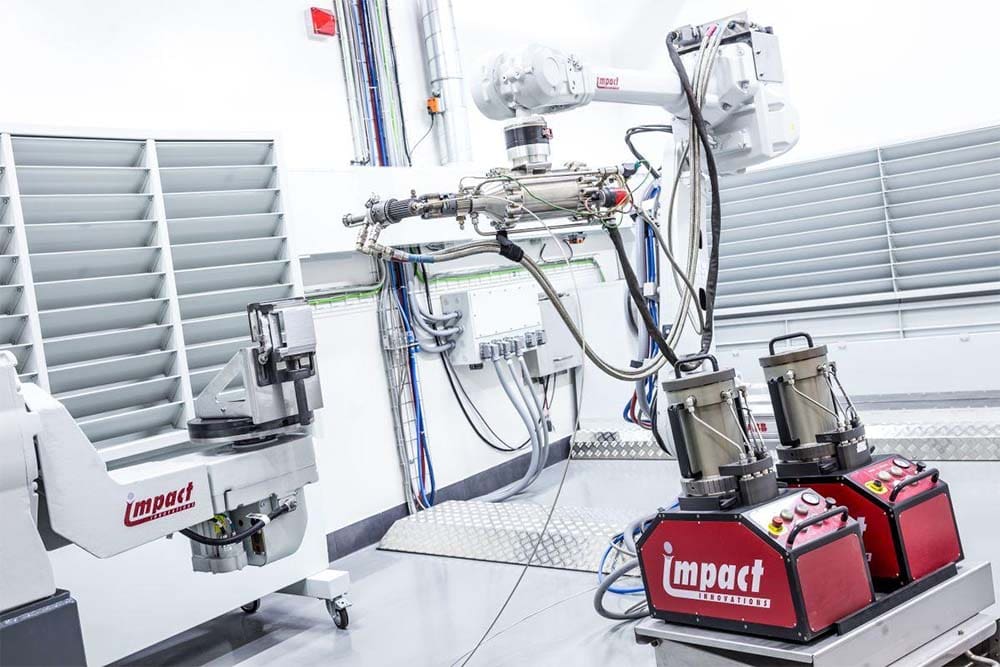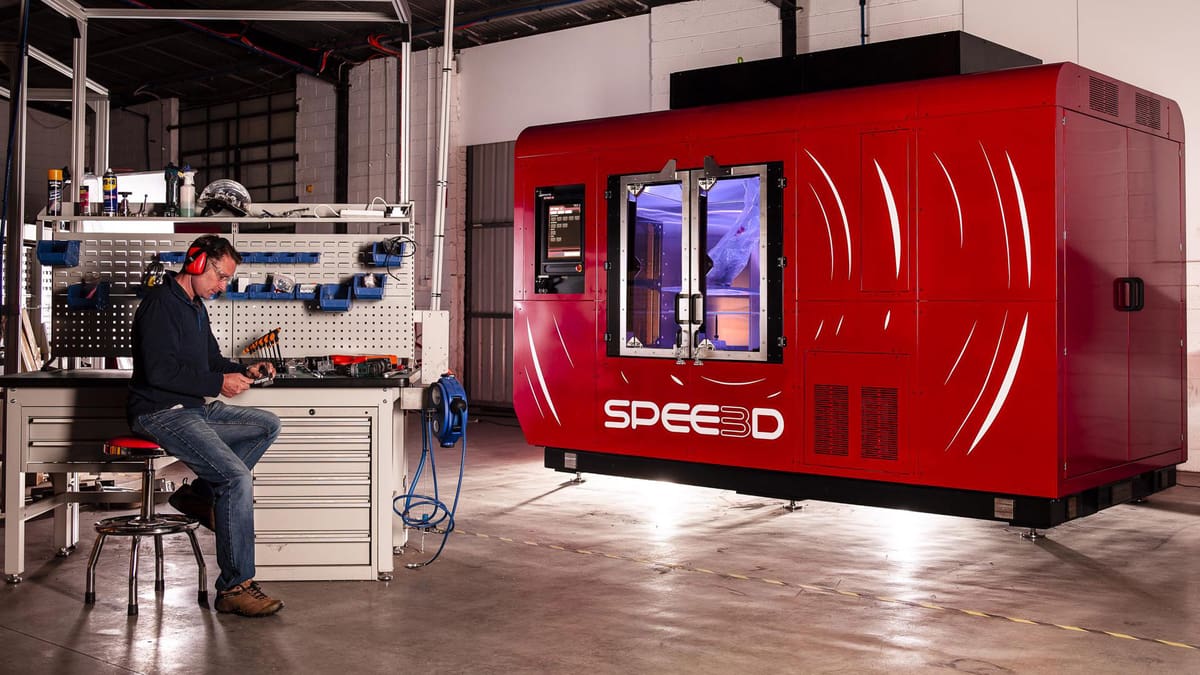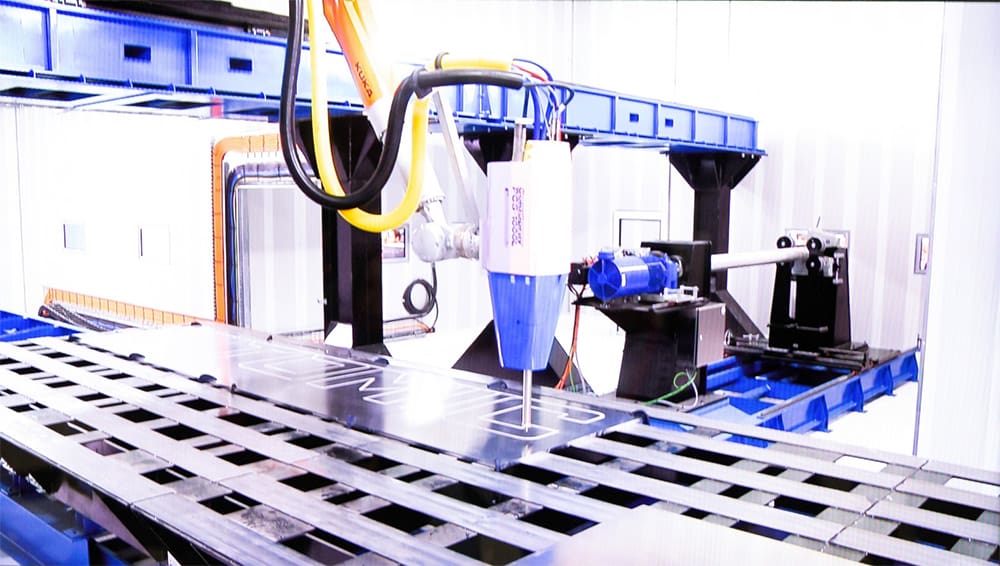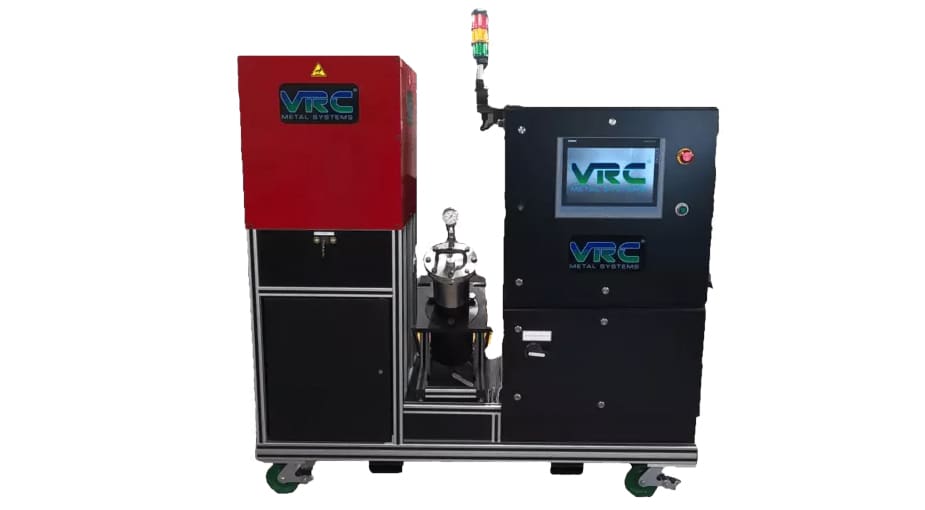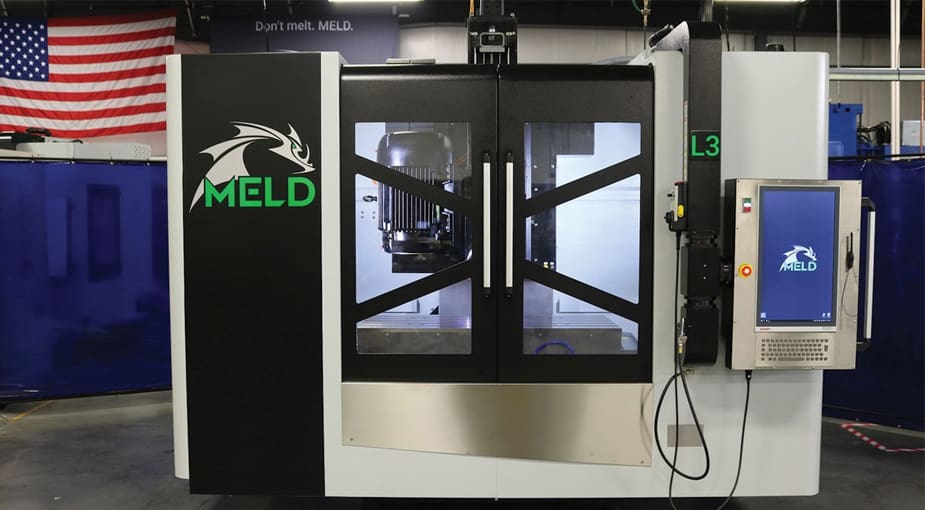From the military to mining to commercial aviation, many of our most important industries rely on complex metal machinery. When parts from these machines break or wear down, it’s often impossible to repair them with welding because the heat can damage the part (or nearby parts) or the repair will introduce weaknesses. These parts then need to be remanufactured, which is a slow, inefficient, and expensive process.
A type of 3D printing technology called “cold spray” offers a solution.
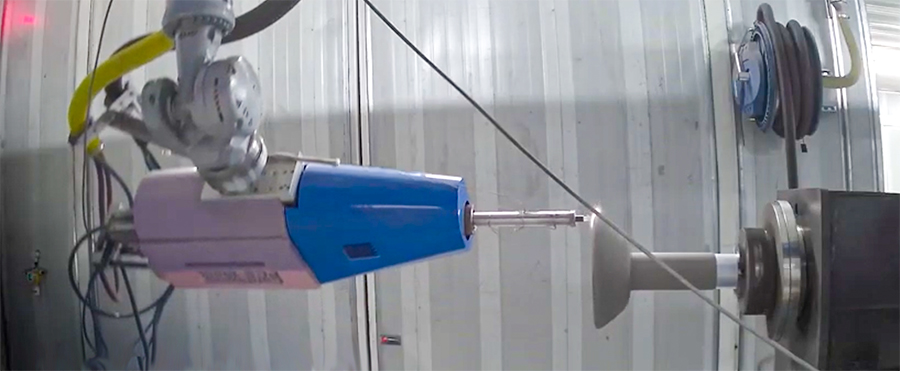
Cold spray is a manufacturing technology that sprays metal powders at supersonic speeds to bond them without melting them, which produces almost no thermal stress. Since the early 2000s it’s been used as a coating process, but more recently, several companies have adapted cold spray for additive manufacturing because it can layer metal in exact geometries up to several centimeters at about 50 to 100 times higher speed than typical metal 3D printers.
For additive manufacturing, cold spray is being used to quickly manufacture metal replacement parts and for on-location repairs and restoration of metal components, such as military equipment and machinery in the oil and gas industry, saving companies potentially millions in remanufacturing and interruptions in workflows. Repaired parts, in some cases, can be better than new ones.
Also of great interest in aerospace, the technology is being used to create complex rocket parts in pure copper and other materials in hours, instead of weeks, at a much lower cost. This type of cold spray technology is known as cold spray additive manufacturing (CSAM).
Let’s take a closer work at what CSAM is and how it’s upending metal additive manufacturing.
The Basics of Cold Spray
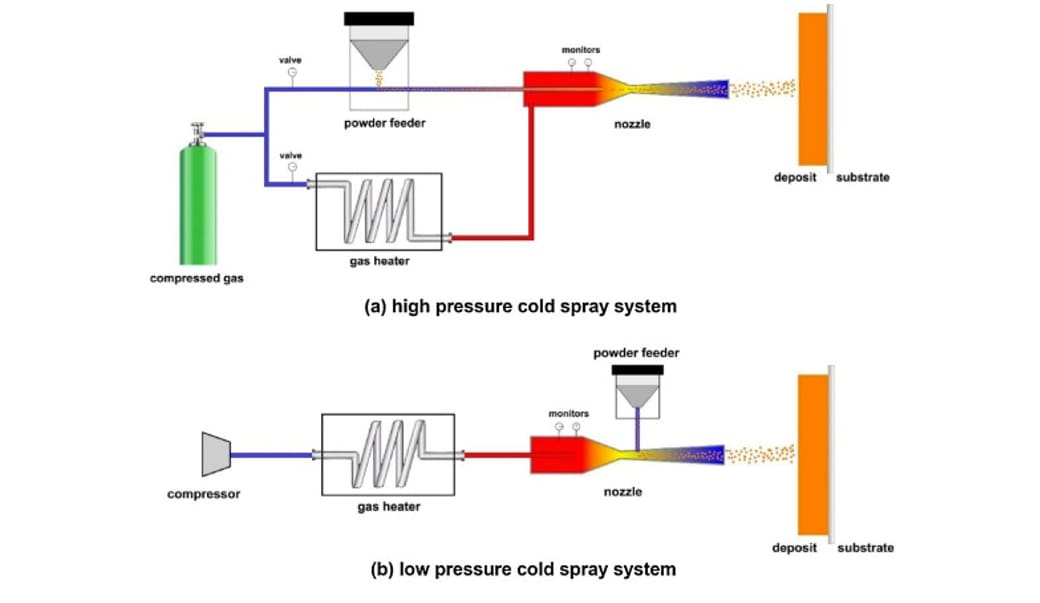
Based on technology developed by Russian scientists in the 1980s, cold spray works by injecting metal powders into a rocket nozzle delivering pressurized gases – air, nitrogen, or helium – at supersonic speeds.
The name cold spray comes from the fact that the metal particles do not melt, rather, they impact upon and stick to a metal substrate in a process known as “plastic deformation” creating a metallurgical bond as well as mechanical interlocking. Because cold spray occurs in the solid state (not melted), it also produces materials that are not susceptible to porosity, hot-cracking, or other common problems that plague melt-based technologies. There’s also no post-processing in a furnace, like some other metal 3D printing technologies.
Robotic machinery controls the movement of either the spray gun nozzle or the build-part itself – or sometimes both.
The 3D printing process works by building up – adding – material layer by layer. Cold spraying can result in zero material loss, which – coupled with the fact that it’s a low energy consumption technology and doesn’t emit any fumes – makes it an attractive sustainable technology. Even better, since cold spray 3D printers can be used on location, the environmental impact of transporting new parts around the globe is eliminated.
There are other benefits as well. In repair applications, cold spray technology extends the life of machine parts, keeping them out of landfills and avoiding heavily resource-dependent replacement manufacturing using traditional methods.
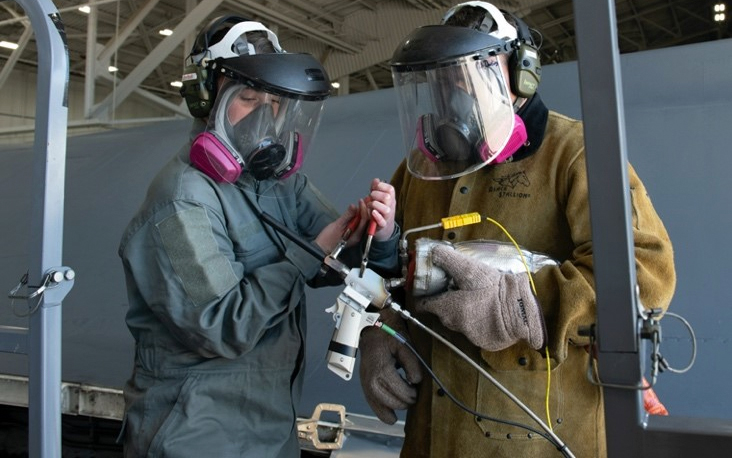
For example, in May the US Air Force restored the “wing faring slip joint” of an active flying aircraft using cold spray technology from VRC Metal Systems.
“During cold spray we used helium gas to accelerate the particles to a speed of Mach 3,” says Brian James, the additive manufacturing chief engineer at the Ellsworth Air Force Base. “Upon impact, the particles become the substrate, forming a strong mechanical bond. The only other alternative to fixing the slip joint, if we didn’t use cold spray, would be to remove and replace the part, which would cost roughly $500,000 and eight weeks to remove.”
Cold Spray Pros & Cons
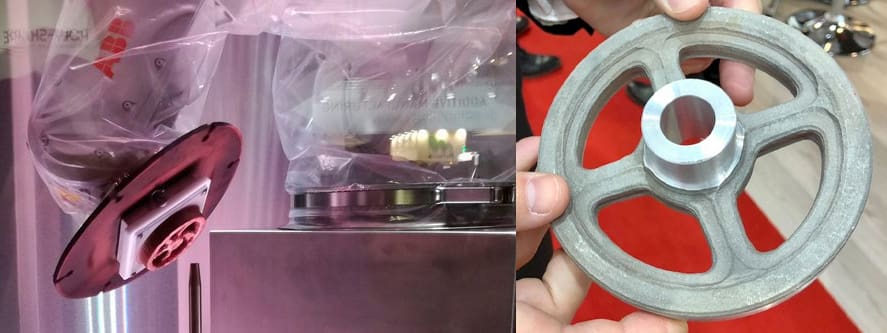
Some of 3D Cold Spray’s benefits have already been mentioned, but there are others. Let’s summarize:
- Up to 100 times faster than other metal 3D printing
- Wide range of metals
- Emits no fumes or waste
- Portable and enables on-site manufacturing or repair
- A solid state process eliminating metal warping, cracking, or porosity
- Produces no oxidation and can generate high-density materials
- Because the metal is not melted, there’s a potential to embed sensors or electronics within a part during the build
- No special atmosphere is needed, enabling in-the-field and large-scale applications
- The process can be used to bond different metals together; some companies are even developing processes for bonding metals with ceramics and plastics
There are also some drawbacks to Cold Spray printing:
- Affordability. Currently machines are only available from a handful of manufacturers.
- Products require a secondary milling process to provide smoothing and to sharpen edges
- Cheaper compression processes using ambient air are best suited to softer metals like copper, aluminum, or aluminum-bronze; harder metals like steel or titanium require the use of helium or nitrogen, which increases costs
- There is a limited geometry of printed shapes due to process physics
- The biggest sector using Cold Spray currently is defense; there may be limited utility for the private sector at present
Metals Used in Cold Spray
CSAM enables joining dissimilar metals without the metallurgical mismatch issues seen in other additive processes. A wide range of material combinations can be printed in a single part opening the design space to enable property gradients and engineered material.
- Titaniums
- Coppers
- Steels
- Aluminum
- Nickels
- Gold
- Silver
- Platinum
- Niobium
- Tantalum
- Zirconium
- Molybdenum
Who's Using Cold Spray Now
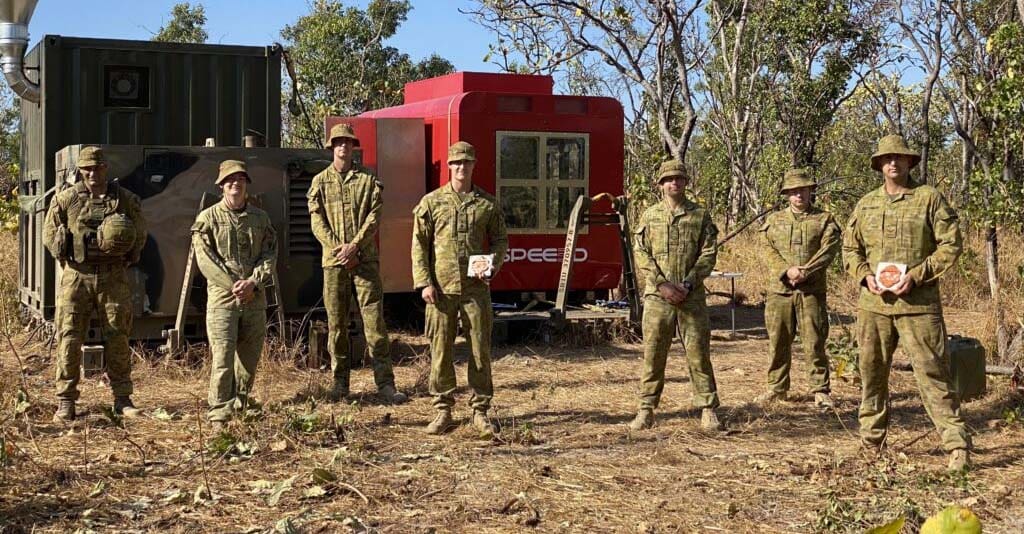
Cold Spray for Metal Repair
Beginning in 2012, the U.S. military has used Cold Spray technology – in collaboration with companies like VRC Metal Systems – to repair aircraft components like magnesium gearbox housings and aluminum castings. This has extended the life of vehicles like the AH-64 Apache helicopter and the B1-B bomber, keeping these vessels out of the scrapyard and saving the military money.
“Cold spray is an emerging technology that will enable the Army to reclaim worn components that were previously replaced with new parts. This new technology reduces lifecycle cost and improves systems availability,” says US Army materials engineer Gehn Ferguson, who conducted research on cold spray to repair costly turret gun mounts on the Army’s M2 Bradley Fighting Vehicle.
The cost of a new gun mount is more than $25,000, but a cold spray repair costs approximately $1,000, according to Army research. Additionally, the cold spray process improves readiness by reducing the time that a Bradley is out of service while lessening the burden on the supply chain by reducing the necessity for stockpiling new gun mounts.
The Australian military also has its eye on cold spray. In 2020, the Australian 3D printer company Spee3D completed a case study in which they trained Australian soldiers to use their cold spray 3D printing technology in the field. Their printers were strapped to Australian army trucks and taken out in the bush, successfully printing in difficult environmental conditions, including heat of 40ºC and humidity at 90%, as well as ample dust and storms.
Spee3D’s experiment showed that it was possible for army units to use cold spray 3D printing to be self-sufficient in the field. Among several examples, the team was able to print an aluminum bronze gunner’s ratchet, at a weight of 2 kg, in 60 minutes. This tool is needed to operate the Australian Light Armoured Vehicle Machine Gun. Using Spee3D’s printer, the item cost about $100 USD to make. The soldiers also printed an aluminium bronze hinge that’s an essential part for the safe operation of manual fuel pumping (pictured below) in 10 minutes at a cost about $35.
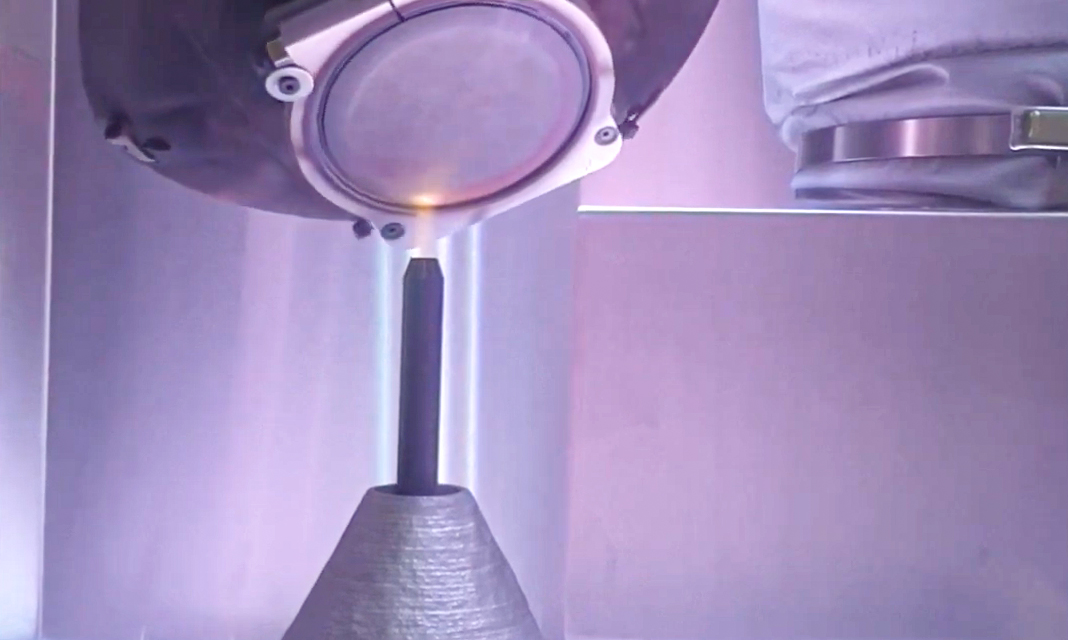
Cold Spray for Aerospace
Rocket nozzles and combustion chambers are exposed to severe demands and the conventional manufacturing methods is tedious and costly. Spee3D printed a 17.9-kg copper rocket nozzle liner (below) on their WarpSpee3D printer in just over three hours at a print cost of $716. With traditional manufacturing methods, this part would take 6 months to produce and cost tens of thousands of dollars, according to Spee3D.
NASA recently hot-fire tested a cold spray printed bimetallic thrust chamber assembly at its Marshall Space Flight Center. “Testing of the RDT Advanced Lander Propulsion Additive Cold-spray Assembly (ALPACA) chamber went very well and demonstrated a new technology capability for NASA and industry partners,” says Thomas W. Teasley, an engineer at Marshall.
An aerospace orthogrid is a type of grid structure that supports the skin of spacecraft. With cold spray, the German company Impact Innovations was able to manufacture orthogrids (below) of several centimeters in height additively without wasting valuable aluminum alloy.
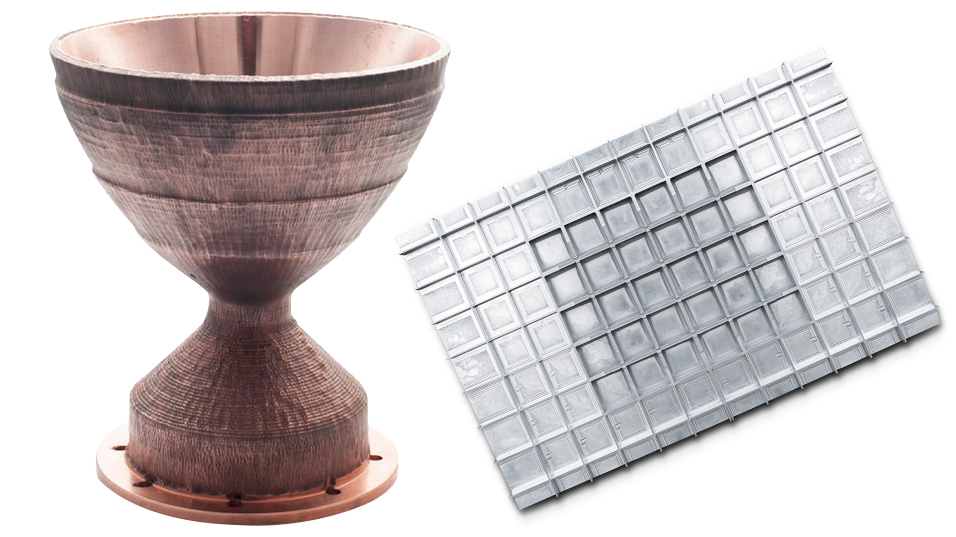
Future of Cold Spray
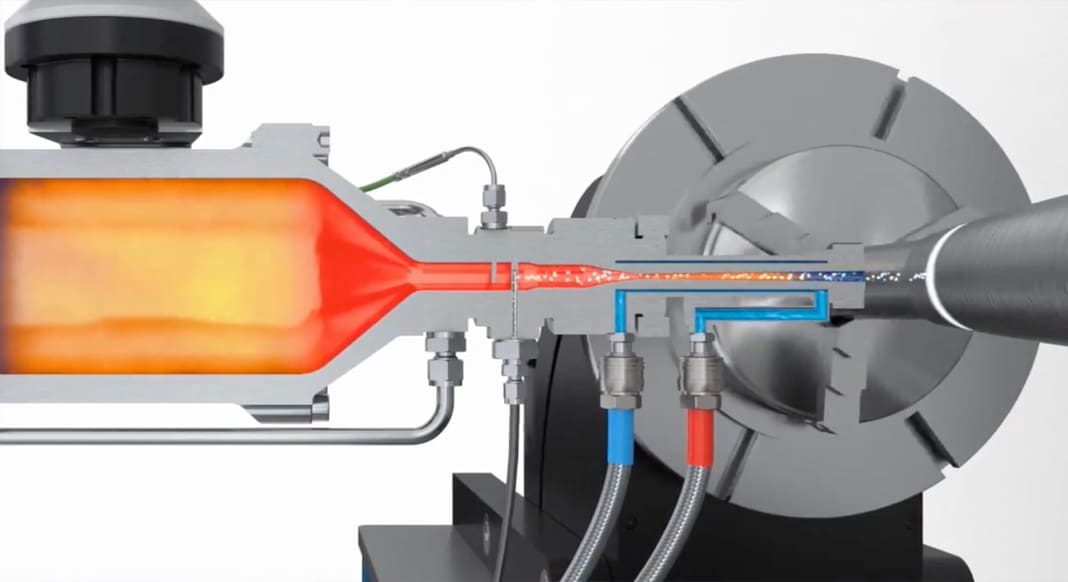
Despite widespread interest, especially from military sectors, cold spray 3D printing is still in its infancy. Undoubtedly, many uses have yet to be discovered. But its portability, affordability, and multi-functionality assure that it will be used in many applications for years to come.
The future of cold spray as an additive manufacturing process hinges on solving the limitation of geometrical control of the deposit shape. In other words, CSAM lacks the fine details and complex geometries available with other AM processes.
One area of future impact will surely be in environmental sustainability. As a recent research paper concluded, the technology “has the potential to change the future of the manufacturing world with remarkable sustainable benefits.”
U.S. military research projects future applications in fields from electronics, to automotive, to nuclear power, and scientists are looking into ways to reduce costs further by using a liquid acceleration system rather than gas.
Another possibility to reduce costs is to find a cheaper source of effective accelerant gases like helium. Spee3D founder Byron Kennedy points to theoretical helium mining on the moon and other extraterrestrial locations. “If we do find a supply of helium in outer space,” says Kennedy, “Cold spray gets better and better.”
And speaking of space, with increased exploration beyond the confines of Earth, cold spray printing could certainly play a role there as well. Taking a trip to Mars? What if ship components break down? It might prove essential to have a cold spray 3D printer on board to safely and efficiently produce a replacement.
That is just speculation, of course. What is certain is that cold spray technology is creating new possibilities in metal manufacturing. It is a technology to keep track of in the coming years.
Cold Spray 3D Printers
Impact Innovations
Based in Germany, Impact Innovations has been a specialist in high pressure cold spray equipment for decades. This year, they introduced the cold spray system EvoCSII billed as a plug and play solution for single parts and series production.
The smaller spray gun called EvoCSII 5/8 is suitable for spraying low-melting materials, such as pure copper, zinc, aluminum, nickel, and their alloys. The larger version the Impact Cold Spray Gun EvoCSII 6/11 can also spray all other less ductile metals, such as stainless steel, magnesium, Inconel, titanium, and carbide-based mixtures.
Spee3D
Australian 3D printer manufacturer Spee3D calls its patented metal cold spray tech Supersonic 3D Deposition additive manufacturing technology (SP3D). They offer two printers, the LightSpee3D and the WarpSpee3D and a Spee3Dcell, which packages their printers together with a heat treatment oven and a CNC 3 axis milling machine.
Recently, Spee3D received a grant from the Australian government to manufacture metal 3D printed rocket engines for Australia’s emerging industrial space industry using its cold spray technology.
https://www.youtube.com/watch?v=7fB1YmiasV0
Titomic Ltd.
Titomic, another Australian 3D printer manufacturer, offers tailored and turn-key 3D printer solutions for a range of manufacturing and R&D. The company calls its cold spray tech “Kinetic Fusion” and offers it in the TKF 9000 and TKF 1000 metal 3D printers.
The TKF 9000 provides a custom-built, autonomous robotic production line capable of on-demand additive manufacturing of load-bearing structures and specialty surface coatings. The smaller TKF 1000 is Titomic’s modular additive manufacturing system, engineered to support a range of low to mid-size production applications to industry, academia, and research organizations. The off-the-shelf, turnkey additive manufacturing system offers rapid and agile manufacturing, prototyping, custom parts, and pilot runs prior to mass production.
As with Spee3D, Titomic has new funding from the Austrian government to develop aerospace cold spray applications. In this case, it’s to manufacture and commercialize low carbon emission “green” titanium space vehicle parts and layered materials for enhanced radiation shielding in space.
VRC Metal Systems
US-based VRC Metal Systems initially developed a system to provide repairs to weapons for the US Dept. of Defense, where the machine’s hand-held capability and mobility were essential design features. Since then, the company has developed commercial systems and turn-key cold spray systems, including additive and subtractive methods. VRC also remains heavily involved in developing cold spray and advanced manufacturing solutions for the Department of Defense.
VRC Metal Systems provides custom solutions for cold spray and hybrid (additive manufacturing and subtractive manufacturing) 3D printers plus off-the-shelf models, including the Gen III and the VCR Raptor. Both units are portable, cold spray systems with hand-held or robotic applicators which can operate remotely.
Meld Manufacturing
US-based Meld Manufacturing’s technology is not cold spray, but we include it here because of its similarities to cold spray in application.
Like cold spray, Meld is a solid-state process (meaning the metal does not reach the melting point) and offers a wide range of capabilities, including additive manufacturing, coating applications, component repair, metal joining, and custom metal part fabrication. It uses off-the-shelf metals in solid or powder form to create fully dense parts by using high pressure and friction to make the metal malleable.
The Meld solid-state 3D printing process was chosen by the National Shipbuilding Research Program to reduce the lead times and efficiency of large steel castings.
License: The text of "Cold Spray Metal 3D Printing Tech & Printers" by All3DP Pro is licensed under a Creative Commons Attribution 4.0 International License.





